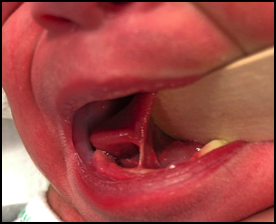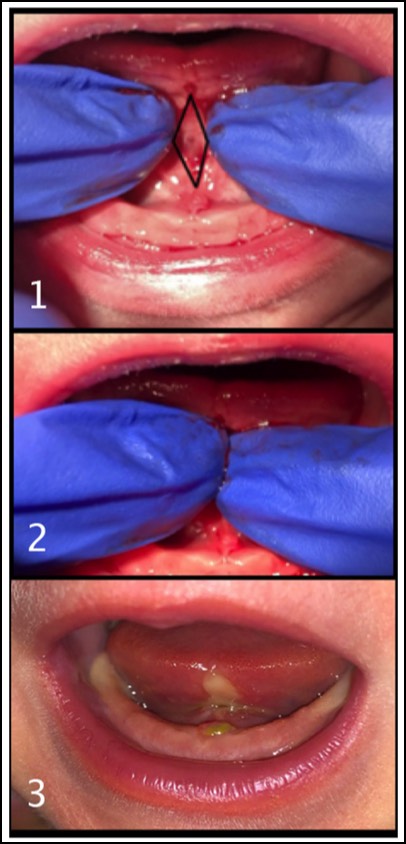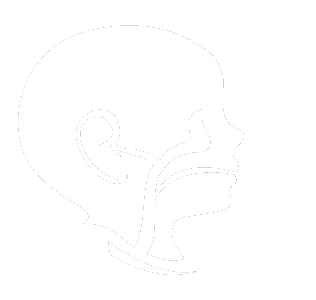Frenotomy (Release of Tongue Tie)

In this context, the "frenulum" refers to the "lingual frenulum", which is the thin vertical band of tissue under the tongue. Everyone has a lingual frenulum, some are shorter and tighter than others, and in some cases they can restrict the motion of an infant's tongue which can make nursing difficult. This is known as "ankyloglossia" and is also called a "tongue tie". There is also a frenulum under the upper lip, which is called the "labial frenulum", and when this is short and tight, it is called a "lip tie".
What is a frenotomy?
Frenotomy is the medical term for "cutting the frenulum". Some people use the term "frenectomy", which technically means "removing the frenulum". This is not really what is done when we do this for newborns, so I don't use this term. There is another procedure called "frenoplasty" which means "fixing the frenulum". This refers to a procedure to lengthen the tight band under the tongue under anesthesia, repairing the cut with sutures. While this is sometimes done in children, it is usually done after age 2-3 for speech issues.
Why would a baby need a frenotomy?
Frenotomy is done to improve nursing. If the tongue is tethered, it can be hard for a baby to make a seal, so they end up gumming, which can cause nipple pain. A poor latch can also cause slow, inefficient feeding and issues with weight gain. Frenotomy is a very quick, simple procedure. While it doesn't always improve feeding, it usually does and there is little downside. I recommend it in cases where there are these types of nursing problems, especially if the frenulum is short and tight. In some cases, you don't really see the frenulum, but it is still a tethering band under the lining of the mouth ("posterior tongue tie").
Many people request frenotomy even if there is no feeding problem because they are concerned about it causing speech issues later on. There is not much evidence to suggest that this is true, so I rarely do this for babies who are feeding well. Occasionally for very severe tongue ties, I will release the frenulum to improve the appearance of the tongue.
Some doctors recommend also cutting the labial frenulum to improve nursing. I generally don't recommend that for two reasons. The upper labial frenulum (under the upper lip) doesn't seem to affect nursing as much as a tongue tie does. Furthermore, this band is much thicker, so cutting it leaves a larger wound. In rare cases, this can heal with scarring with further tethers the upper lip. I occasionally do an upper labial frenoplasty, but this is done after age 1, under anesthesia with sutures, to prevent the formation of a gap between the front teeth (a "diastema"). Most lip ties stretch out on their own before then.
When would you do a frenotomy?
Generally, the earlier this is done the better. Newborn infants have fairly thin frenulums, there is usually very little bleeding, and they tend to forget about it after a few seconds. I often do this in the hospital newborn nursery for the convenience of the family, to limit the need for another visit to a doctor's office after discharge and because the procedure is so much easier in the first few days of life. The older the baby gets, the thicker the frenulum gets, the more it bleeds when cut, and the more discomfort the baby has afterwards. I rarely do this after around 2 months of age, especially since by then most parents have worked out some sort of successful feeding regimen with nursing, pumping, nipple shields and/or formula supplementation.
What should I expect after the procedure?
When done early, babies rarely have any significant pain, beyond the few seconds that the procedure actually takes. Their discomfort is no more than they might exhibit with a vaccination, a diaper change or taking a blood sample. Years ago, I would inject local anesthesia into the area and it seemed to make their pain much worse, lasting for much longer.
All babies have fussy periods, but crying during the week after frenotomy is generally no more frequent than without the procedure. Pain medication is generally not necessary, and doesn’t seem to make any difference in their overall mood. Of course, if there is any concern, I am always happy to see your child at any time.
When can I feed my baby after the procedure?
Nursing or bottle feeding may be done immediately after frenotomy. It helps soothe the baby, and will help stop any minor bleeding that may occur.
What do I need to do after the procedure?
The following is very important to ensure good healing and to prevent recurrence of the tongue tie. Any wound will eventually heal by “contraction” – a normal process that pulls the edges together. Our goal is to mold the tissue of the floor of the mouth so that it heals flatter with better tongue extension. There will always be a small band under the tongue where the lining of the mouth heals – this is normal and does not mean that the tie has come back. But doing the massage will give a much better result.
Gloves aren’t necessary – just wash your hands before and after - but if you prefer, you can use them.
If you look under the tongue, you will see a diamond shaped opening where the tongue tie was cut (drawn onto picture #1). This is the area that has to heal. Over time you will see yellow or white material in this area (picture #3). This is a scab, it is a normal part of the healing process. It is not an infection or thrush, it does not require antibiotics or any other medication, but contact me if you have any questions. When the scab is gone in around two weeks, the wound has healed and you can stop the massage.
The massage is done by touching the tips of your index fingers together, and pushing firmly on the diamond area. You then lift the tongue by pushing your fingers up toward the roof of the mouth while holding pressure. It’s important to keep your fingertips together (picture #2), so that you stretch the area (don’t let them slip to the sides). You won’t injure the baby by doing this, but they may be fussy. Don’t be afraid to apply some pressure to get a good stretch. If your index fingers are too big, you can use your pinkies or even one finger, as long as you stay in the midline, over the cut area.
The following is very important to ensure good healing and to prevent recurrence of the tongue tie. Any wound will eventually heal by “contraction” – a normal process that pulls the edges together. Our goal is to mold the tissue of the floor of the mouth so that it heals flatter with better tongue extension. There will always be a small band under the tongue where the lining of the mouth heals – this is normal and does not mean that the tie has come back. But doing the massage will give a much better result.
Gloves aren’t necessary – just wash your hands before and after - but if you prefer, you can use them.
If you look under the tongue, you will see a diamond shaped opening where the tongue tie was cut (drawn onto picture #1). This is the area that has to heal. Over time you will see yellow or white material in this area (picture #3). This is a scab, it is a normal part of the healing process. It is not an infection or thrush, it does not require antibiotics or any other medication, but contact me if you have any questions. When the scab is gone in around two weeks, the wound has healed and you can stop the massage.
The massage is done by touching the tips of your index fingers together, and pushing firmly on the diamond area. You then lift the tongue by pushing your fingers up toward the roof of the mouth while holding pressure. It’s important to keep your fingertips together (picture #2), so that you stretch the area (don’t let them slip to the sides). You won’t injure the baby by doing this, but they may be fussy. Don’t be afraid to apply some pressure to get a good stretch. If your index fingers are too big, you can use your pinkies or even one finger, as long as you stay in the midline, over the cut area.

This massage should be done at twice a day for about 10-15 seconds each time, pausing at the end of the stretch with the tongue lifted up. Don’t worry if you don’t follow that schedule exactly, but do your best to do this during the healing process over the first two weeks, to keep the tongue tie from coming back. Watch the video at the bottom of this page to see the correct technique.
You can also help your baby improve their sucking by having them do exercises during this healing period. Place your finger in their mouth and let them suck on it. Then slowly pull it out, letting them pull against you (like a tug of war game!). This strengthens the tongue and lips, and will improve feeding in general.
What about follow up?
The follow up visit is in three weeks, please call my office for an appointment. In most cases, this can be done as a telemedicine appointment, and I can check the floor of the mouth adequately through FaceTime or any other video conferencing system. Of course, I am happy to see your child in the office in person if you prefer.
Massaging the frenotomy site to promote healing.
